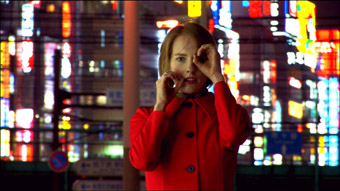 |
Shona Erskine, Will Time Tell? by Sue Healey |
She closes her eyes. Snippets of what might be memory abruptly interpose; of Erskine dancing with abandon in a scarlet coat on a massive outdoor wooden deck as if caught on coarse surveillance film by a camera on high, followed by a shot of ornamental carp languidly swimming, each scale etched in crisp focus. The dancer, still as a sign beside her, then stands feet planted on an urban Japanese rail platform as a train blurs in acceleration close behind. Its wind lifts her coat. The hurtling of the carriage flattens, becoming a restless field on the same plane as her stillness. Story-time is woven into being in the space between repeated multiple threads of visual and audio imagery. This film is a movement story of one woman's travel experience. The stuff of time, its non-narrative materiality, is palpable in the juxtapositions of tempo mostly, but not exclusively, in edited human actions, choreographed and incidental.
The instantaneous momentum of the opening is arrested in a sharp focussed mid-shot. Erskine wearing a bright coloured 70s styled mini dress performs, with fingers like those of an orchestra conductor, a filigree of gestures carving sharp lines in the air. One stands out—her look back at us through ‘binoculars’ shaped by her hands in front of her eyes. This motif accrues weight as it pops up developed periodically by the five Japanese dancers Sue Healey worked with on her Asialink fellowship. It playfully evokes the continual observation of visitors to new places that travel prompts.
Is the narrative I read constructed by the film’s altering of human movement speeds and the rhythm of the edits, or are the grain, pace and colours, like the palette of a designer, meant for sensual appreciation? A Japanese dancer wearing a hoodie and the red-coated Erskine perform a smooth, delicate duet of immaculate unison in a Tokyo laneway. The choreography creates a shared time zone that bonds them, as pedestrians stride past unconcerned. This is time for reverie in a busy city street. This contrast between the pace and focus of the task-oriented pedestrians and meditative dancers is an entrancing compositional device in Will Time Tell? It returns later when the five Japanese dancers and Erskine fan symmetrically across a gravel avenue in front of a massive tori shrine gate, performing a gestural choreography with composure. Underpinned by a traditional sounding plucked instrumental and choral singing, tourists walk by, sometimes reversed in the edit.
Elsewhere, abrupt switches in music underscore stark edits. For example, koto-like strings cut to something like Japanese klezmah as our protagonist joins a man in a cafe by gently laying her head on white triangular-folded napkins set on a tabletop. As they sit up, the camera glides up and over from behind. It steadies on the relaxed dance of their hands, echoing each other’s shapes and grips in the warm dimness. There is a soupcon of voyeurism in the moment of touch. We see this male dancer next as one amongst five others, fishing in unison off a wooden boardwalk surrounding a pool in the middle of the city. The groups' collective action is digitally interrupted, sped up and slowed. When images of the carp return, the camera lingers on the flowing rhythm of the fish.
Another jump cut takes us to a grainy Super 8 group portrait, the redcoated dancer included. They smile to camera as their eyelids close with imperceptible slowness. Is this a holiday movie grab from a Nihon vacation manipulated in the woman's memory to embody a collective public meditation? Her intimate and gentle connections with people are tinged with the distance that travel compels.
Will Time Tell? vividly embodies the difference between time ‘for’ and time ‘to act.' Periods for contemplation jostle with times to meet and be with others.
The film concludes with two contrasting vignettes. Reminiscent of a 19th century paper-cut miniature, Erskine’s wind blown silhouette dances on the crest of a paved hill against the smokey pastels of clouds just after sunset. In one long shot and in one dance she draws together fragments of movements glimpsed earlier. An aeroplane, rendered tiny in this wide shot, traverses the sky. The oompah of an organ grinder ushers in the end—a man places Erskine’s dress, red coat and shoes on a tailor’s mannequin for sale on a Tokyo street.
Will Time Tell?, a film by Sue Healey in collaboration with performers Shona Erskine, Ryuichi Fujimura, Makiko Izu, Mina Kawai, Yuka Kobayashi, Norikazu Maeda, director of photography Mark Pugh, composer Ben Walsh, editor Peter Fletcher; 2006
© Yana Taylor; for permission to reproduce apply to [email protected]








 back
back